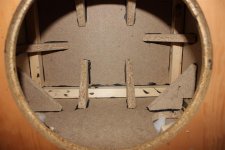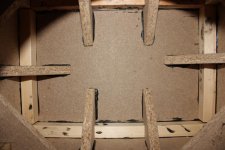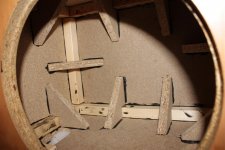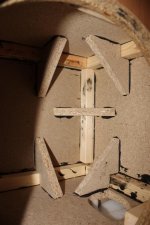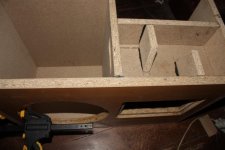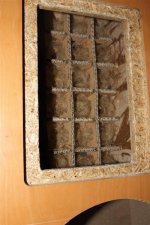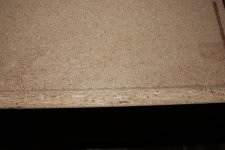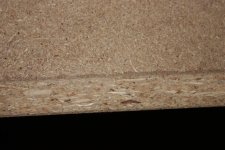I disagree.
The back panel is being a passive radiator.
Fibrous damping will have no affect. Panel damping -- like bituminus pads -- increases mass without increasing stiffness so just tunes the "PR" lower in frequency.
You need to brace the back -- vertical holey panel braces, with your cabinet size, at least 2 of them -- from front to back would be a good start.
dave
The back panel is being a passive radiator.
Fibrous damping will have no affect. Panel damping -- like bituminus pads -- increases mass without increasing stiffness so just tunes the "PR" lower in frequency.
You need to brace the back -- vertical holey panel braces, with your cabinet size, at least 2 of them -- from front to back would be a good start.
dave
Good point about the panels serving as passive radiators.
I have some foam rubber floor padding with texture exactly as pictured here:
This will be my dampening material and should perform great. Half an inch thick, good density and very affordable. The same material sold for audio purposes such as speaker cabinet making would literally cost 10 times the price for 1/4 the quantity. The front baffle is recessed, angled and mounted to 2, 2x2 beams 40 inches long screwed into each side panel. The vibration was earthquake like so I see the sense in bracing the rear not only the sides.
I'm not concerned about "perfection", just optimal performance without turning this into a physics project. I propose if I use 3 + shaped braces top, center and bottom made from 2x2's with full dampening of all panels aside from the baffle I'll reach my goal.
I have some foam rubber floor padding with texture exactly as pictured here:
An externally hosted image should be here but it was not working when we last tested it.
This will be my dampening material and should perform great. Half an inch thick, good density and very affordable. The same material sold for audio purposes such as speaker cabinet making would literally cost 10 times the price for 1/4 the quantity. The front baffle is recessed, angled and mounted to 2, 2x2 beams 40 inches long screwed into each side panel. The vibration was earthquake like so I see the sense in bracing the rear not only the sides.
I'm not concerned about "perfection", just optimal performance without turning this into a physics project. I propose if I use 3 + shaped braces top, center and bottom made from 2x2's with full dampening of all panels aside from the baffle I'll reach my goal.
That stuff is great for play mats or for protecting stuff (say dozens of speakers) from a hard work bench, but will do little towards solving your issue.
Have a look here: http://www.diyaudio.com/forums/full...ons-advice-stereo-ht-setup-3.html#post2310367
Keep in mind we are discussing bracing a box for a single 8" and the examples are for a 6.5" and a 5" driver.
dave
Have a look here: http://www.diyaudio.com/forums/full...ons-advice-stereo-ht-setup-3.html#post2310367
Keep in mind we are discussing bracing a box for a single 8" and the examples are for a 6.5" and a 5" driver.
dave
In terms of dampening I'm certain it will work. I've seen lesser materials such as cheap egg crates work which have very little density and much of the wave still hits the panels but, it's enough to mellow out the passive effect. Having tested the stuff in front of speaker cabinets and thrown a piece in the rear of my completed cabinet, it's a pretty good damping material.
In terms of bracing to counter the excessive flexing and radiating that's taking place, I would truly need an elaborate inner caging like what you've linked which would sure kill both birds with one stone.
I just can't justify adding that much more weight to a cabinet that will not only need to be mobile but, will have 9 identical twins. My ultimate goal is volume. I realize I'll have a cleaner, more focused sound by adding the complex acoustically tuned bracing but in a sense, it's compromising the intentions.
In terms of bracing to counter the excessive flexing and radiating that's taking place, I would truly need an elaborate inner caging like what you've linked which would sure kill both birds with one stone.
I just can't justify adding that much more weight to a cabinet that will not only need to be mobile but, will have 9 identical twins. My ultimate goal is volume. I realize I'll have a cleaner, more focused sound by adding the complex acoustically tuned bracing but in a sense, it's compromising the intentions.
I should point out, I want some of the sound to pass through the vents.
I do not subscribe to your claim that the range of sound isn't going to reflect off those panels and out the ducts and that I will only lose HF since I've used this technique in success with several other designs. I'm using sealed tweeters, there really are no HF generated internally in that cabinet and if such were the case, much smaller vents would be required to "leak" highs.
Those ducts are going to vent mids and bass which I have a major excess of.
It's called sound reflecting and it's been done quite effectively for thousands of years through architecture. You're literally saying a ventilation duct isn't going to vent but when driving them to an effective level for say, an audience of a few hundred people, they will completely fulfill their purpose. You're also trying to claim the foam won't work, sorry but strike 2. Then you're saying the sound waves won't even see the reflectors, strike 3. Based on that claim, the ducted braces in your link wouldn't work yet you're promoting them. Both systems work, just in different ways and for very different purposes.
I see more of an agenda to push a home hi-fi design here where as I'm looking for projection and some resonance, I simply don't want my cabinet running all over the floor and leaking sound through the rear panel.
That complex bracing system you shared is going to steal an awful lot of cubic volume and all the ports in that bracing are going to emphasize specific frequencies. In a sense, it's truly creating turbulence but it's an intentional, controlled turbulence. Some frequencies waves are going to be divided and break up, others are going to get concentrated and come into focus. Then you're going to need to stuff it with batting to compensate for the loss of internal cubic volume and it's going to serve double duty by absorbing the frequencies you're dividing and causing to break up which would otherwise produce distortion.
Those frequencies will literally get clipped by those braces. The point in such a design is taming rogue, wide projection volume and bringing it into a focused radiance thus limiting it's projection range. That's not a true loudspeaker, that's a hi-fi speaker.
People call designs such as those you linked Loudspeakers but, they're really not. Those are Hi-Fi speakers, what I'm finishing up is a loud speaker. That design is about home fidelity where the SPL I'll be pushing is beyond tolerable in such applications. I'm looking to produce high SPL on large stages, auditoriums, amphitheaters etc. The last thing I want to do is stuff the cabinet and used tuned port braces because I'll sacrifice volume.
I appreciate the help but, it's really not accurate in this application and applies to home hi-fi. It did however raise some concerns which I've now rectified but I must say again, your hypothesis about the ducts is really inaccurate.
I do not subscribe to your claim that the range of sound isn't going to reflect off those panels and out the ducts and that I will only lose HF since I've used this technique in success with several other designs. I'm using sealed tweeters, there really are no HF generated internally in that cabinet and if such were the case, much smaller vents would be required to "leak" highs.
Those ducts are going to vent mids and bass which I have a major excess of.
It's called sound reflecting and it's been done quite effectively for thousands of years through architecture. You're literally saying a ventilation duct isn't going to vent but when driving them to an effective level for say, an audience of a few hundred people, they will completely fulfill their purpose. You're also trying to claim the foam won't work, sorry but strike 2. Then you're saying the sound waves won't even see the reflectors, strike 3. Based on that claim, the ducted braces in your link wouldn't work yet you're promoting them. Both systems work, just in different ways and for very different purposes.
I see more of an agenda to push a home hi-fi design here where as I'm looking for projection and some resonance, I simply don't want my cabinet running all over the floor and leaking sound through the rear panel.
That complex bracing system you shared is going to steal an awful lot of cubic volume and all the ports in that bracing are going to emphasize specific frequencies. In a sense, it's truly creating turbulence but it's an intentional, controlled turbulence. Some frequencies waves are going to be divided and break up, others are going to get concentrated and come into focus. Then you're going to need to stuff it with batting to compensate for the loss of internal cubic volume and it's going to serve double duty by absorbing the frequencies you're dividing and causing to break up which would otherwise produce distortion.
Those frequencies will literally get clipped by those braces. The point in such a design is taming rogue, wide projection volume and bringing it into a focused radiance thus limiting it's projection range. That's not a true loudspeaker, that's a hi-fi speaker.
People call designs such as those you linked Loudspeakers but, they're really not. Those are Hi-Fi speakers, what I'm finishing up is a loud speaker. That design is about home fidelity where the SPL I'll be pushing is beyond tolerable in such applications. I'm looking to produce high SPL on large stages, auditoriums, amphitheaters etc. The last thing I want to do is stuff the cabinet and used tuned port braces because I'll sacrifice volume.
I appreciate the help but, it's really not accurate in this application and applies to home hi-fi. It did however raise some concerns which I've now rectified but I must say again, your hypothesis about the ducts is really inaccurate.
Last edited:
VOTR, to reduce the bass vibrations, I'd try a single brace, front to back, similar to a 1960B cab. Maybe two.
And that fuzzy covering that's so common provides some relief from leaking highs smearing the sound, as well as protecting the wood. If you want mids from the ports, there's no point in absorbing them internally.
...and guys, we're talking about SPLs that invalidate many old hifi saws, like the one about the center of the panels vibrating more than the corners. When the vibrations saturate the cabinet's ability to absorb them, everything changes. There's no way you can make a portable PA cabinet sonically opaque. All you can do is try to make the cabinet's contribution to the soundfield a pleasing improvement to the sound of the singer's voice.
And that fuzzy covering that's so common provides some relief from leaking highs smearing the sound, as well as protecting the wood. If you want mids from the ports, there's no point in absorbing them internally.
...and guys, we're talking about SPLs that invalidate many old hifi saws, like the one about the center of the panels vibrating more than the corners. When the vibrations saturate the cabinet's ability to absorb them, everything changes. There's no way you can make a portable PA cabinet sonically opaque. All you can do is try to make the cabinet's contribution to the soundfield a pleasing improvement to the sound of the singer's voice.
Keriwena I am going to go with the original design.
While I know the reflection braces will get me criticism, I've had very good results with this technique in the past. The before and after change in volume and perceivable bandwidth is rather bold.

The reflectors serve double duty by bracing the rear and sides, the front panel I want maximum resonance and the vents also provide relief. If I still have too much loss and vibration, I will dampen the sides with the foam rubber as well.
I also realize my mid position reflectors will bounce sound into the baffle but this is desired. If they didn't serve a purpose in conjunction with the vents, I would simply just use a big sealed box with some braces and stuff the hell out of it. The box is already exactly 15 cubic feet so any batting material will exaggerate that further which is undesired.
The goal for now is to prevent loss through the top and rear panel and stop the cabinet from "walking" while getting a fair amount of resonance and peak projection. All the dampening material and complex, vented bracing suggested would most definitely do the opposite of this.
While I know the reflection braces will get me criticism, I've had very good results with this technique in the past. The before and after change in volume and perceivable bandwidth is rather bold.

The reflectors serve double duty by bracing the rear and sides, the front panel I want maximum resonance and the vents also provide relief. If I still have too much loss and vibration, I will dampen the sides with the foam rubber as well.
I also realize my mid position reflectors will bounce sound into the baffle but this is desired. If they didn't serve a purpose in conjunction with the vents, I would simply just use a big sealed box with some braces and stuff the hell out of it. The box is already exactly 15 cubic feet so any batting material will exaggerate that further which is undesired.
The goal for now is to prevent loss through the top and rear panel and stop the cabinet from "walking" while getting a fair amount of resonance and peak projection. All the dampening material and complex, vented bracing suggested would most definitely do the opposite of this.
amazing chameleon
Well hello Violence on the Radio,
i guess that viewing the entire thread rsults for you with the same fascination as it did to me.... the turnover of suggestions and proposals as the result to the change of the Knowledge on information is clear result of missing information in the beginning and at the further stage got better with the information provided to us the readers from you in the further time. I Guess this is a precious lesson to all of us in the forums that answers depend on the uncovering of information and intentions and wishes and data. Let us all hope together that in uprising threads we might all together learn to issue important thoughts and intentions as early as possible and we might all together be able to provide information faster that leeds up to a desired goal.
thanks for the experience and i wish you the best to hit the goal that you had in mind when starting the thread - at least to me it was an interesting experience to follow up the thread...
Well hello Violence on the Radio,
i guess that viewing the entire thread rsults for you with the same fascination as it did to me.... the turnover of suggestions and proposals as the result to the change of the Knowledge on information is clear result of missing information in the beginning and at the further stage got better with the information provided to us the readers from you in the further time. I Guess this is a precious lesson to all of us in the forums that answers depend on the uncovering of information and intentions and wishes and data. Let us all hope together that in uprising threads we might all together learn to issue important thoughts and intentions as early as possible and we might all together be able to provide information faster that leeds up to a desired goal.
thanks for the experience and i wish you the best to hit the goal that you had in mind when starting the thread - at least to me it was an interesting experience to follow up the thread...
So far, so very good
An externally hosted image should be here but it was not working when we last tested it.
Well hello Violence on the Radio,
i guess that viewing the entire thread rsults for you with the same fascination as it did to me.... the turnover of suggestions and proposals as the result to the change of the Knowledge on information is clear result of missing information in the beginning and at the further stage got better with the information provided to us the readers from you in the further time. I Guess this is a precious lesson to all of us in the forums that answers depend on the uncovering of information and intentions and wishes and data. Let us all hope together that in uprising threads we might all together learn to issue important thoughts and intentions as early as possible and we might all together be able to provide information faster that leeds up to a desired goal.
thanks for the experience and i wish you the best to hit the goal that you had in mind when starting the thread - at least to me it was an interesting experience to follow up the thread...
I think the default (e.g. most of) posters here are more focused on building high quality music reproducers. Perhaps many assumed that's what violenceontheradio was shooting for. Like you wrote, if he was more clear with what he was trying to build and what his goals were, there would have been less confusion.
internal bracing of speaker Im building right now
Im not trying to build the best ever, just something ordinary
its not completely dead as is, but very short ressonance
I wouldnt mind doing more, but ressonance will get longer with a high pitch ringing nature
so I leave it as is
well, small bits of felt will be mounted with rubber glue
Im not trying to build the best ever, just something ordinary
its not completely dead as is, but very short ressonance
I wouldnt mind doing more, but ressonance will get longer with a high pitch ringing nature
so I leave it as is
well, small bits of felt will be mounted with rubber glue
Attachments
speakercase lifetime
How many months or years do you demand the speakercase to work ? Is there a reason for using rubberglue instead of woodglue ? usualy rubberglue might weaken the construction instead of stabilizing it because connections become / stay elastic instead of a firm connection ? elastic connection might not stop vibrations that much like firm connections.... and open cutsides of the used wood might drag watermoisture and make the wood itself instabil - i guess it to be a good idea to close open cutsides with woodlacquer to protect the wood against fog ...
internal bracing of speaker Im building right now
Im not trying to build the best ever, just something ordinary
its not completely dead as is, but very short ressonance
I wouldnt mind doing more, but ressonance will get longer with a high pitch ringing nature
so I leave it as is
well, small bits of felt will be mounted with rubber glue
How many months or years do you demand the speakercase to work ? Is there a reason for using rubberglue instead of woodglue ? usualy rubberglue might weaken the construction instead of stabilizing it because connections become / stay elastic instead of a firm connection ? elastic connection might not stop vibrations that much like firm connections.... and open cutsides of the used wood might drag watermoisture and make the wood itself instabil - i guess it to be a good idea to close open cutsides with woodlacquer to protect the wood against fog ...
No offense, but this looks like "down and dirty" PA to me. Plastic(?) woofers, piezo tweeters. So I agree that there isn't much need to get "fancy" inside. Some good bracing will sure help, tho. Couple of 2x4s could really make a difference. Weight is an issue. (I run Meyer Sound gear, it's heavy).
I do believe that keeping mids and highs out of the ports IS a good idea tho. You just want the ports to augment the bass, nothing else. As true for PA as for Hi-Fi. If these were scoops are some other sort of horn, that would be another matter.
Bravo for building your own. And a lot of your own! 10 boxes? Hello sawdust! Just remember, the better you make it, the more you'll like it and the easier the gigs will be. That's money and peace of mind in your pocket.
Just IMHO, YYMV, etc.
I do believe that keeping mids and highs out of the ports IS a good idea tho. You just want the ports to augment the bass, nothing else. As true for PA as for Hi-Fi. If these were scoops are some other sort of horn, that would be another matter.
Bravo for building your own. And a lot of your own! 10 boxes? Hello sawdust! Just remember, the better you make it, the more you'll like it and the easier the gigs will be. That's money and peace of mind in your pocket.
Just IMHO, YYMV, etc.
Is there a reason for using rubberglue instead of woodglue ?
hey, dont be so fast my friend
the box is glued first, with polyurethane, it will last forever
and tight and smooth joints, thats what makes a sturdy construction
bracing is mounted after
what you couldnt see, theres additional internal chambers
upper part and midrange section is dead like a stone
but that a different matter
btw, its for domestic use, no moist issues
and I know it could be much much better
but not this time, or maybe never
if we are talking about doing the best possible, then its a very different game
btw, I have speakers built this way 30 and 40 years ago, and despite having had other owners, and been kicked from place to place, and even stored in moisty barns, still ok
well, maybe not so pretty any more, but in one piece
how long do you want them to last
Attachments
I think the default (e.g. most of) posters here are more focused on building high quality music reproducers. Perhaps many assumed that's what violenceontheradio was shooting for. Like you wrote, if he was more clear with what he was trying to build and what his goals were, there would have been less confusion.
For home fidelity purposes, that is one hell of a nice build tinitus.
But high quality isn't determined or limited to maximum dampening and least resonance or for that matter maximum radiance, volume and a broad projection field. It's largely a matter of which you prefer and, if you want a cross between the two. What I dislike about home hi-fi "loudspeakers" is the loss of desirable harmonics due to the dampening. The music ends up sounding "perfectly synthetic".
I'm essentially going for a cross between the two but leaning more towards resonance and a wide range field of volume projection. My top, bottom and rear panels will be dampened.
My woofers are pretty good grade for the purposes. It's a poly cone with an anodized aluminum laminate, 80 oz. magnet, 96dB etc. An above standard grade woofer in terms of pro audio applications where most everything is paper and accordion suspension because the lower mass resistance produces higher SPL. If I were building a dedicated sub, then sure you could make an argument but at the same time, most pro audio subs use paper cones with accordion suspensions which are unarguably inferior to what I'm using in terms of durability.
Peizos on the other hand...well some are good, some are great, some are garbage. I'd grade these at better than average since at high volumes they are hard to distort but like piezos, the mids are wispy. Still far more desirable than mylar and other poly coned mids. I prefer silk or titanium but the good thing about these is, the piezo tranducers are massive. the size of a silver dollar and have a nice foam rubber insulator between the disc and the paper cone. On the horn tweeter anyway. The bullets are decent. Not great nor bad but one did arrive dead and I now regret not checking them and every woofer when I originally purchased them.
I however will make no argument against the sonic superiority of silk or titanium though they will distort more easily at extreme SPL in most designs unless you pay an arm and a leg for them, no thanks.
The ducts are letting a good peak frequency through of 440 Hz. A nice spectrum of what most today call the midbass range. I chose this band based on a vintage set of cabinets I own that have had a variety of pro audio woofers installed in them.
Last edited:
The Answer is Bubble Wrap!!!!!!!!!!!
Most so called audiophiles over stuff the cabinets and don't have proper bracing to begin with. There are many articles on the web on how to properly brace certain materials in order to create a mechanical grounding effect to evacuate vibrations.
First and foremost, the cabinets have to be extremely sturdy and braced from at least top to bottom.
Second, the very best material to stuff the cabinet with is bubble wrap!!!!!!!!!!!! The medium/small bubble kind. Roll it up and stick it in the box behind the woofers. As unbelievable as this sounds, it's the best damping material out there, for speaker damping. Period. I've been building speakers for almost 15 years now and have tried everything from ridiculously expensive Black Hole 5, to wool, fiberglass, fiberfill, Acousta-Stuf, etc. Bubble wrap WILL give you exactly what you're looking for, lively/punchy/dynamic sound, yet focused.
The entire tried and tested procedure is: Line the cabinet walls with self adhesive 1/2" foam. Then roll up bubble wrap and stuff the remainder of the box behind the woofers.
You will thank me later.
Most so called audiophiles over stuff the cabinets and don't have proper bracing to begin with. There are many articles on the web on how to properly brace certain materials in order to create a mechanical grounding effect to evacuate vibrations.
First and foremost, the cabinets have to be extremely sturdy and braced from at least top to bottom.
Second, the very best material to stuff the cabinet with is bubble wrap!!!!!!!!!!!! The medium/small bubble kind. Roll it up and stick it in the box behind the woofers. As unbelievable as this sounds, it's the best damping material out there, for speaker damping. Period. I've been building speakers for almost 15 years now and have tried everything from ridiculously expensive Black Hole 5, to wool, fiberglass, fiberfill, Acousta-Stuf, etc. Bubble wrap WILL give you exactly what you're looking for, lively/punchy/dynamic sound, yet focused.
The entire tried and tested procedure is: Line the cabinet walls with self adhesive 1/2" foam. Then roll up bubble wrap and stuff the remainder of the box behind the woofers.
You will thank me later.
- Status
- This old topic is closed. If you want to reopen this topic, contact a moderator using the "Report Post" button.
- Home
- Loudspeakers
- Multi-Way
- Cabinet dampening - to stuff or not to stuff?
